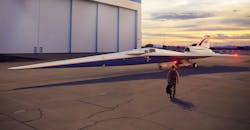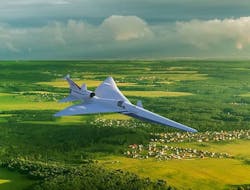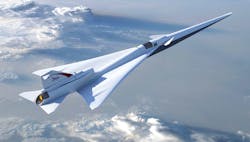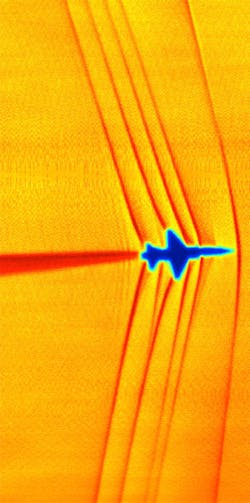The Next NASA X-Plane: Born To Boom
Several aerospace companies are trying to revive supersonic passenger flight and replace and improve on the Concorde, the British and French SST that was retired in 2003. But there are a handful of high-tech hurdles they must first overcome before every carrying a paying passenger: Supersonic airliners are too noisy, create too much pollution, and they cannot meet today’s standards for jet engine efficiency.
To help with that first issue, noise, specifically the sonic booms generated by aircraft breaking the speed of sound, NASA plans on building its first manned X-plane in decades, the X-59 Low Boom Flight Demonstrator (LBFD). The single-engine jet will be built by Lockheed’s Skunkworks as they were the only company to submit a bid on NASA’s request for an aircraft. Lockheed, which will be paid about $247.5 million for the single aircraft has a vested interest in supersonic flight; it is partnering with Aerion on a supersonic 12-passenger business jet.
The NASA Mission
Beginning next year, NASA will look at its own efforts to reduce the intensity of sonic booms and conduct a critical design review of the LBFD, also called the Quiet Supersonic Technology or QueSST. NASA has been studying sonic booms since the X-1 first broke the sound barrier in 1947 and been exploring methods to make those booms quieter. In 2003, for example, NASA flight tested an F-5E Tiger with a highly modified nose portion and validated one boom-reducing theory.
That theory postulated that shockwaves generated from the front and rear portions of a plane as it sped past Mach 1 coalesced or joined together as they expanded away from the plane, creating two thunderous booms when they hit the ground. So, NASA’s X-59 will have a fuselage shaped by aerodynamicists so that there will be small and nuanced volumetric changes from nose to tail designed so that shockwaves off the plane do not come together and coalesce as they move toward the ground. It is hoped they create an S-shaped boom that creates a mild thump as loud as a car door closing, not the classic double-bang of an N-wave sonic boom.
NASA will also incorporate into the X-59 all it has gleaned from the latest in wind-tunnel testing, advanced computer simulation, and CFD, and actual flight tests used to understand boom creation and propagation. For example, last year NASA flew a series of tests using F/A-18s from Kennedy Space Center in Florida. The project, called Sonic Booms in Atmosphere Turbulence (SonicBAT), had the military planes fly a specially configured dive trajectory that creates a shaped boom. The purpose of the flights was to determine what role humid-atmosphere turbulence plays on sonic booms. Turns out that turbulence’ role is unpredictable, according to NASA. Most of the time, the turbulence softens the edges of the boom, but other times it amplifies the boom.
NASA has also investigated ways to boost the aerodynamic efficiency of supersonic wings. One tool they dug out of mothballs and updated for this investigation is schlieren photography. It’s a 150-year old photographic technique for visualizing airflow. More on that later.
After a successful design review, Lockheed Martin’s Skunk Works will start construction and then deliver the plane to NASA in 2021. It will be sized and designed to replicate the sonic boom of a small supersonic airliner cruising at Mach 1.4 at 55,000 ft. In Phase Two, the plane will be thoroughly flight tested on the supersonic test range at Edwards Air Force Base. The flights will test and confirm the safety of the aircraft and demonstrate its sonic boom.
Then from 2023 through 20205, Phase Three, the plane will make “community response” flights staged out of Armstrong Flight Research Center located inside Edwards AFB. There it will flyover some as-yet-unnamed California cities. Then it will demonstrate its hushed sonic boom over four to six other cities around the U.S. The communities’ responses to the sonic booms, along with readings from ground and flight instruments, will be given to the U.S. and international flight agencies. Those agencies could use this data to rewrite the rules governing supersonic flight over land and open the hangar doors to faster-than-sound passenger and cargo travel over the U.S. and other countries. If the booms are too loud and obnoxious, however, supersonic flight over land will remain a dream.
The X-59
The X-59 will be based on a preliminary Lockheed design developed under a 2016 contract with NASA. It will be about 94 feet long, have a 29.5-ft wingspan, and weigh 32,000 lb at take-off (fully fueled). It will be powered by a single GE F414 jet engine with 22,000 lb of thrust. Top speed should be Mach 1.5, or 990 mph.
To save design time and costs, many of the parts are off-the-shelf with proven performance and reliability. The engine, for example, is currently used in F/A-18E/F Hornet fighter/attack jets. The cockpit, ejection seat, and canopy are from a Northrop T-38 Talon, a trainer aircraft used for years by NASA astronauts to maintain proficiency in high-performance jets. And the landing gear is the same as those on the Lockheed F-16 Falcon.
The overall design is calculated to generate a much-less intense sonic boom than traditional supersonic aircraft. The plane will be long and thin with swept-back wings, factors that aerodynamic engineers have determined prevent the shockwaves created when the plane goes supersonic from joining together and growing larger. Instead, the shockwaves remain separated, leading to a less intense sonic signatures. That’s also why the aircraft has a long nose, much like the Concorde. The nose is practically empty and only serves to break up the bow shock coming off the front of the aircraft.
The long, pointy nose did create some design challenges, just as it did on the Concorde. Flight rules when the Concorde flew demanded that pilots be able to see the runway when they were landing and taking off. That meant engineers had to devise a way for the nose to tilt downwards almost 13 on takeoffs and landings then go back to its proper position while in flight. To improve visibility on the X-59, Lockheed is using a forward mounted camera. For taxiing and ground handling, a second camera under the nose looks downward when the landing gear is extended. The long nose will still present problems for taxing and limit its turning radius. This will likely restrict the aircraft from operating out of smaller airfields.
The aircraft’s engine is also mounted above the wide delta wings, so the wings block some of the engine noise and shockwaves from the nacelle from reaching the ground and contributing to the sonic boom.
“The airplane is a brand-new shape,” says LBFD program manager at Lockheed Martin Peter Iosifidis. “Everything else within the plane, however, is commercially off the shelf or salvaged from other aircraft.”
The plane will also fly slower than the Concorde since speed is directly related to the sound level of the boom. The cruising altitude will be above 50,000 ft, about 15,000 ft higher than most airliners’ cruising level. Higher altitudes soften the booms.
The plane is designed to replicate the sonic boom of a small supersonic airliner. It is predicted to have a maximum boom loudness of 75 PLdb when going Mach 1.5 at 55,000 ft. The Concorde generated a boom of about 110 PLdb when cruising at Mach 2. (PLdb stands for “perceived decibel level. It was developed to compare the loudness of aircraft in flight and takes into account the frequency content, rise time, and several other acoustic parameters.) Flight experts think a PLdb of 75 would be low enough that regulators would permit unrestricted supersonic flight over land, but NASA’s goal is to get the X-59’s boom down to 70 PLdb.
“This is a purpose-built experimental research aircraft,” says director for air vehicle designs and technologies at Lockheed Martin, Dave Richardson. “It is not a prototype for a supersonic business jet or weapon systems. It is not a derivative or some other modification an existing airplane.”
The Camera
To ensure the actual boom meets NASA’s CFD-predicted sonic signature, the U.S. space agency will use a variation of schlieren photography, a method of visualizing air flowing away from an object, in this case, the X-59. It was invented by German Physicist August Toepler in 1864 to study supersonic motion. (The term “schliere” translates as “streak.”)
It relies on the fact that light rays bend when they encounter density changes in the air the plane is flying through. The set up shown below is used to take schlieren photos in a wind tunnel. But the principles are the same as taking photos of a flying plane.
A pair of concave mirrors are mounted on either side of the wind tunnel's test section. A bright light source sends light through a slit placed so that light reflected from the mirror forms parallel rays that pass through the test section (aircraft model). On the other side of the test section, the parallel rays are collected by the second mirror and focused to a point on the knife edge. The rays and images are then recorded to be studied later.
If the parallel light rays pass through a density change or gradient in the test section, they bend or are refracted. In the above schematic, the model placed in supersonic flow creates shockwaves which are thin regions of large pressure, temperature, and density changes. A ray of light passing through the shockwave is bent, as shown by the dashed line. The light ray does not pass through the focal point, because it gets stopped by the knife edge. In the recorded image, darkened lines show where there are density gradients. The model blocks any light rays, so it is seen in silhouette
For the X-59 flights, NASA plans on capturing schlieren images of the shockwaves to confirm they match predictions the space agency has made on the intensity of the X-59’s shockwaves and resulting sonic boom. But the images will need to be taken while the X-59 is in flight, not in a wind tunnel. So, NASA conducted experiments to validate BOSCO, (background oriented schlieren using celestial objects, a variation of schlieren photography), and BOSCO II, a second variation that partially validated schlieren photography taken from flying aircraft of another flying aircraft.
In BOSCO, the setup included a hydrogen filter, using the sun as the background, placing the camera on the ground, and using telescopes to maximize the size of the sun’s image on the camera. The hydrogen filter lets only light emitted by hydrogen on the sun’s surface be captured. This will give the sun’ surface a granular texture so researchers will be able to see the shockwaves more easily.
For BOSCO II flights, NASA used the same ground-based camera, but the test plane had to fly precisely at 10,000 ft, directly between the camera and sun, and maintain a speed slightly higher than Mach 1. This meant keeping the plane inside an imaginary 100-ft bubble while that bubble was moving faster than the speed of sound. The pilots managed the task and ground crews captured images. Now NASA will reduce the size of the camera and mount it in a chase plane that will pace the X-59 as it flies its supersonic test demonstrations.
NASA will fly more BOSCO II flights to get an idea of what schlieren images look at close range, including what kinds of shockwaves structures they can discern. They also need to validate and become comfortable with the image quality of the smaller, airborne camera, and coordinating between both planes to keep them aligned







